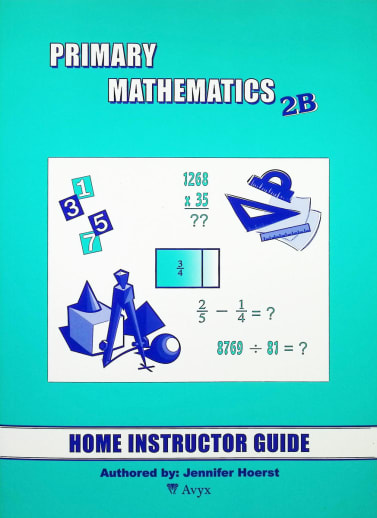If you're looking for a little more help on how to teach Primary Math, these support guides are just what you need. Each guide provides a suggested teaching schedule, detailed notes to the instructor referencing specific course book pages, games and activities, complete textbook and workbook answers, step-by-step solutions for all word problems, and mental math pages. Suggested games and activities may require additional materials, such as a base-10 set, multilink cubes, hundred chart, etc. Currency replacement pages (depicting U.S. money) are also included. Guides for all levels can be used with both the Singapore and U.S. editions, although you may need to make minor adjustments for level 2B. ~ Anh
Primary Math US 2B Home Instructor Guide for 3rd edition
Description
This guide is meant to help instructors using Primary Mathematics 2B when teaching one student or a small group of students. It should be used as a guide and adapted as needed.
It contains:
- Objectives
- Notes to the instructor, providing added explanation of concepts
- Instructional ideas and suggested activities
- Game ideas to reinforce concepts from the corresponding textbook pages and learning tasks
- Homework assignments
- Answers and solutions to all the learning tasks, workbook exercises and reviews and textbook practices and reviews
Included is a suggested weekly schedule and pages for mental math (in the appendix). Practices and reviews in the text can, for the most part, be done independently by the student. Some can be used as part of the lesson. Since some of the practice questions are challenging, they provide good opportunities for discussion . The mental math pages can be used as worksheets and many can be done orally. They can be used any time after they are referenced in this guide and can be used more than once.
This guide can be used with both the U.S. edition and the third edition of Primary Mathematics. Items specific to either edition, such as different answers, different page numbers, and different exercise numbers, are clearly indicated. U.S. spellings are used in this guide, and answers involving number words use the current U.S. convention of reserving the word "and" for the decimal and not using it in number words for whole numbers.
Primary Math U.S. Edition uses the Singapore methodology (based on the Singapore’s Ministry of Education Syllabus) that employs a concrete-to-pictorial-to-abstract approach to teaching. Concrete illustrations are incorporated heavily in the early grades, gradually giving way to more abstract representations so that math is learned meaningfully. The program builds strong problem solving, critical thinking, and computational skills through well-chosen practice problems. Primary Math focuses on topics such as using whole numbers, fractions, and decimals, perimeter, area, volume, angles, quadrilaterals, symmetry, time, length, weight, money, graphs, and algebraic expressions. American money and U.S. measurements are included in the U.S. edition of this curriculum.
Each grade consists of two semester sets to be completed in one year. The ‘A’ textbook and workbook would be first semester, and the ‘B’ textbook and workbook would be second semester. Although the pace of the course really depends on the individual student, 2-3 pages in the text is usually enough for one day's lesson. Brief teacher instructions are provided in the textbook’s preface, but the Home Instructor Guide offers answers and more in-depth instruction and how to use optional manipulatives for the parent. Sets include text, workbook, and Home Instructor’s Guide.
We also offer supplemental Primary Math U.S. Extra Practice Books for each grade level. Optional, these helpful Extra Practice books provide additional practice problems organized by grade level topics. Convenient math manipulative kits are also available. Compared to Saxon Math, Primary Math encompasses a narrower scope. While Saxon Math covers coordinate graphing, negative numbers, square roots, and probability, these topics are omitted from Primary Math and are not covered until New Elementary Math. The smaller scope, however, allows the program to emphasize the basics. Primary Math focuses on the four arithmetic operations (using whole numbers, fractions, and decimals), perimeter, area, volume, angles, quadrilaterals, symmetry, time, length, weight, money, graphs, and algebraic expressions (introduced in 6th grade). Saxon Math moves a bit slower introducing Algebra in Math 87.
| Product Format: | Softcover Book |
|---|---|
| Grade: | 2 |
| Brand: | Avyx |
| Author: | Jenny Horst |
| ISBN: | 9781887840606 |
| Length in Inches: | 10 |
| Width in Inches: | 7.5 |
| Height in Inches: | 0.5 |
| Weight in Pounds: | 1.03 |

